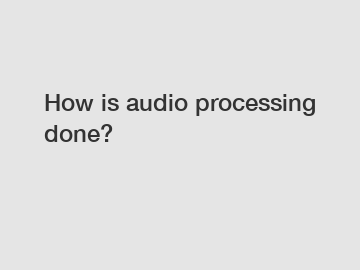How is audio processing done?
How is Audio Processing Done?
Audio processing refers to the manipulation of audio signals to achieve a desired outcome. It involves various techniques and tools to enhance, modify, or correct audio recordings. From music production to speech recognition systems, audio processing plays a crucial role in numerous applications. This article will explore the process of audio processing, its techniques, and the tools used.
Digital Audio Processing.

In the modern era, audio processing is predominantly performed on digital audio signals. Analog audio signals are converted into digital format using analog-to-digital converters (ADC) before any processing can be applied. Once in the digital domain, a plethora of techniques can be employed to alter the audio signal.
Equalization.
Equalization, commonly known as EQ, is one of the fundamental processes in audio processing. It involves modifying the frequency response of an audio signal to enhance or attenuate specific frequency ranges. This technique is used to balance the sound, remove unwanted frequencies, or add emphasis to certain elements.
Effects and Filters.
Audio effects and filters are used to enhance creativity and bring character to audio recordings. Effects like reverb, delay, chorus, and flanger add spatial depth and texture to the sound. Filters, on the other hand, allow the manipulation of specific frequency ranges or the removal of unwanted noise.
Compression and Limiting.
Compression is another crucial technique in audio processing. It helps to control the dynamic range of an audio signal by attenuating the louder parts and boosting the quieter ones. This ensures a consistent level throughout the recording, making it sound more polished and controlled. Limiting, a form of compression, is used to prevent audio signals from exceeding a certain threshold, thereby avoiding distortion.
Noise Reduction.
Noise reduction is a technique used to eliminate or minimize unwanted background noise from audio recordings. There are various methods used for noise reduction, such as spectral subtraction, noise gating, and adaptive filtering. These techniques help remove hiss, hum, or any other undesirable elements from the recording, resulting in cleaner and clearer audio.
Pitch Correction.
Pitch correction is widely used in music production to correct inaccuracies in the intonation of musical performances. It involves analyzing the pitch of an audio signal and automatically adjusting it to the desired pitch. This technique can fix minor flaws or create unique vocal effects.
Tools Used in Audio Processing.
The process of audio processing requires specialized tools and software. Digital audio workstations (DAWs) provide a comprehensive set of features and plugins to manipulate audio signals. They offer a wide range of effects, equalizers, compressors, and other processing tools that can be applied to audio recordings.
Popular audio processing plugins include equalizers like the FabFilter Pro-Q, compressors like the Waves SSL G-Master Buss Compressor, and reverbs like the Soundtoys Little Plate. These tools allow audio engineers and producers to shape the sound, add depth, and enhance the overall quality of the recordings.
Conclusion.
Audio processing is a vital step in the creation of high-quality audio recordings. It involves techniques like equalization, effects, compression, noise reduction, and pitch correction. By utilizing specialized tools and software, audio engineers can shape and manipulate audio signals to achieve the desired outcome.
If you require professional audio processing for your project or want to learn more about the techniques and tools used, feel free to contact us. Our team of experts is ready to assist you in achieving the best possible audio quality for your recordings.
Contact us to discuss your requirements of Voting Conference System Unit, 4k Video Wall Solutions, Conference Room Audio Video. Our experienced sales team can help you identify the options that best suit your needs.

Comments
0